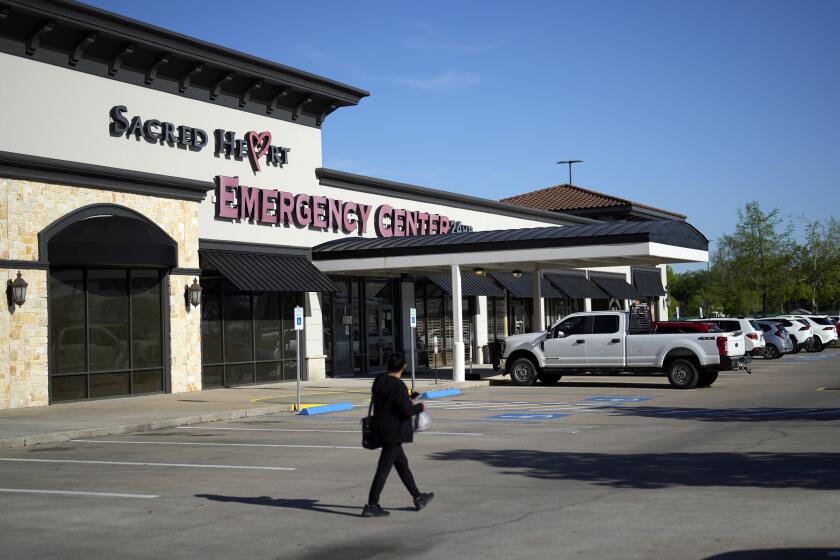Spacewalk to Fix Discovery’s Belly Gets a ‘Go’
Fears that small protrusions on the underside of the shuttle Discovery could result in dangerous levels of heat during reentry prompted NASA on Monday to order a first-of-its-kind spacewalk as early as Wednesday to repair the damage.
The decision was made after an engineering team could not assure space agency managers that Discovery could land safely as is.
“We had a thorough technical discussion,” said N. Wayne Hale Jr., deputy shuttle manager.
“We came to the conclusion that we don’t have enough information to feel really good about this. Therefore, the remedy is easy.”
The plan is to send astronaut Stephen Robinson out on the International Space Station’s robotic arm during Wednesday’s previously planned spacewalk.
Once he reaches the protruding “gap fillers” -- ceramic-coated fabric spacers placed between the shuttle’s heat-resistant tiles -- he will try to pull them out.
If that doesn’t work, he will use a cutting tool to trim them back.
Although the other crew members on Discovery won’t be able to see Robinson on the underside of the craft, cameras on a special boom will keep him in view.
Hale said there should be little danger of damaging neighboring silica tiles during the repair, but even if there was damage, it would only be surface scarring and pose little danger.
While the risks of a spacewalk are well understood, the potential danger of flying home with two gap fillers sticking out an inch or more is a large unknown.
Part of the problem is that there are very little data to work with because no other vehicles fly at the shuttle’s speed. At hypersonic speeds, such as the 17,000 mph that Discovery will be traveling when it reenters Earth’s atmosphere, even tiny disruptions in the airflow could cause turbulence and increase heating as much as 30% in the area just behind the protrusions.
The shuttle’s insulating tiles are generally designed to withstand more than 2,300 degrees, while the reinforced carbon panels on the nose cone and leading edges of the wings can accommodate temperatures above 3,000 degrees.
Some engineering studies in the past few days have forecast temperatures behind the gap fillers in the high 2,000s.
While shuttles have landed before with protruding gap fillers, this is the first time that they have been observed in flight.
Thousands of gap fillers are inserted into the spaces between the tiles that cover most of the orbiter. Some are designed to provide additional heating protection; others keep the tiles in place.
Engineers concluded that the two offending gap fillers could be removed without causing problems during reentry.
The gap fillers are not attached to the tiles but are independently glued to the underlying structure.
“The force required to remove a gap filler is one to five pounds, a very small force,” Hale said.
He emphasized that there is no panic about the protrusions, just a desire to be cautious.
One internal engineering study, however, was more worrying.
Engineers design into systems a safety factor to make sure that they are not pushing the limits of the astronauts or the equipment. They like to have a safety margin of 1.4.
“Below that, the community gets very concerned,” said Chuck Campbell, a NASA aerodynamics expert.
The study on the gap filler problem revealed a margin of 1.0, far below the comfort level.
Although the repair is expected to be done Wednesday, managers said Monday that they would agree to an extra day if the astronauts wanted one to prepare themselves.
Discovery’s spacewalking astronauts -- Robinson and Soichi Noguchi -- have been accumulating hours of valuable experience during the mission.
On Monday, they spent seven hours and 14 minutes on a spacewalk. They have 14 hours and 4 minutes of spacewalking experience so far.
The most important job for the astronaut crew Monday was to replace a failed gyroscope on the International Space Station.
Dangling at the end of Discovery’s robotic arm like a telephone repairman on the world’s tallest cherry-picker, Noguchi wrestled with the bolts and electrical connections that held the faulty gyroscope in place.
He then guided its washing machine-sized replacement into position and bolted it down.
The old gyroscope failed June 8, 2002, during a visit by the shuttle Endeavour. A second gyroscope has been inoperable since March. Robinson repaired that one during the first spacewalk Saturday.
A third has been operating spottily, raising fears among the international consortium that operates the station that it might lose all but one of its four gyroscopes.
It was clear that the spacewalkers have grown more comfortable on their second of three planned walks in space.
They joked and dredged up old song lyrics as they clambered around the outside of the space station.
“Fresh catch of the day,” Noguchi joked as he snared a tool.
“Soichi, you’re the man,” Robinson said as he watched Noguchi peel back the canvas cover protecting the station’s four gyroscopes.
“It was a fantastic day,” Mark Ferring, space station flight director, said after the spacewalk. “They look like veterans up there.”
The astronauts were comfortable enough to take some time out for sightseeing.
“If you look down,” said astronaut Andrew Thomas, an Australian by birth who was controlling the spacewalk from inside the orbiter, “the city we’re going past is the city of Sydney.”
Noguchi and Robinson responded with appreciative oohs and ahs.
More to Read
Start your day right
Sign up for Essential California for news, features and recommendations from the L.A. Times and beyond in your inbox six days a week.
You may occasionally receive promotional content from the Los Angeles Times.






